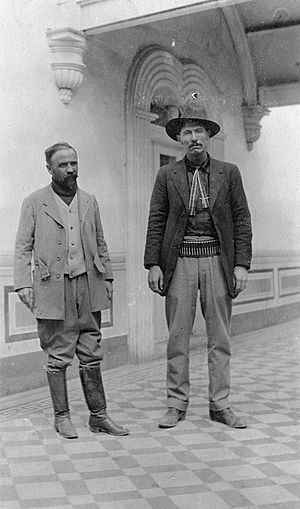Plan Orozquista facts for kids
The Plan Orozquista was a special document created by Mexican revolutionary General Pascual Orozco on March 25, 1912. It's also known as the Plan of the Empacadora because it was signed in a cotton factory. In this plan, Orozco declared that he no longer supported the government of Francisco I. Madero. He believed Madero had betrayed the Mexican Revolution.
Contents
Why the Plan Was Made
Pascual Orozco was a hero of the Mexican Revolution. Along with Pancho Villa, he helped defeat the old government's army in the Battle of Ciudad Juárez. This victory led to President Porfirio Díaz stepping down and leaving the country.
After Díaz left, Madero signed the Treaty of Ciudad Juárez. This treaty set up a temporary government and called for new elections. However, it kept the old army, which Orozco's forces had just defeated. The revolutionary fighters were then told to go home.
When Madero became president in October 1911, he didn't quickly make changes to land ownership. This was a big promise in his 1910 Plan of San Luis Potosí. Because of this, another revolutionary, Emiliano Zapata, rebelled against Madero in November 1911 with his own plan, the Plan of Ayala.
By March 1912, Orozco also rebelled against Madero. His plan gathered many armed forces in Chihuahua, which was a big problem for Madero's new government. Madero sent General Victoriano Huerta to stop the rebellion. Orozco released his plan on the same day a general sent by Madero failed in battle.
The Plan Orozquista was very long, with over 35 different sections. It started with strong criticism of Madero. Orozco felt Madero had ignored his help in the Revolution and pushed him aside after becoming president. Historians like Michael C. Meyer say the Plan was very important because it talked about social and economic problems.
What the Plan Said
The Plan Orozquista had many points. Here are some of the main ideas:
Madero's Actions Criticized
- Article 1 said that Madero had "falsified and violated" his own Plan of San Luis Potosí.
- Articles 2, 3, 4, 7, and 8 accused Madero and his family of bad actions. They also claimed Madero was too close to the U.S. government and bankers, putting Mexico's future in their hands. However, some historians believe Orozco's followers were not always against American interests.
- Article 9 declared Madero and his supporters "traitors to the Fatherland" and outside the law.
- Article 10 said the 1911 elections for president and vice president were not valid. Because of this, it said Madero was not recognized as president.
Changes to Government and Property
- Article 12 called for taking back any special deals or agreements Madero, his family, or friends had made. These would be taken by the government.
- Articles 13 and 14 stated that local government officials could stay in their jobs. But only if they supported the new revolution and stopped supporting Madero.
- Article 16 said that no single person would be named as a temporary leader. It also called for getting rid of the vice president's job.
- Article 17 explained how the country would change after Orozco's side won.
Economic and Worker Reforms
- Article 32 demanded that all railways in Mexico become fully owned by the government.
- Article 33 asked that Mexican workers replace foreign workers in private companies. It also called for Mexicans and foreigners to be paid the same amount for the same work.
- Article 34 aimed to "improve and raise the conditions of the working class." It had five key points:
* Getting rid of "company stores" (tiendas de raya), where workers had to buy goods from their employers. * Paying wages in real money, not company scrip (special money only used at company stores). * Limiting the number of hours people could work. * Stopping children under 10 from working. Limiting hours for those aged 10-16. * Increasing daily wages. * Making sure factories were clean and safe for workers.
Land Reform
- Article 35 focused on the "agrarian problem," which meant issues with land ownership. It proposed seven ways to fix this:
* Recognizing the rights of people who had lived peacefully on land for 20 years. * Making land ownership papers valid and better. * Returning land that had been taken unfairly. * Redistributing unused land across the country. * Taking land from very large landowners who did not farm their land. This land would then be divided to help more people farm. * The government would create special bonds to pay for the land it took. * Creating a new law to manage land reform.
The Plan ended by asking Mexicans to join the fight. It urged them to stop supporting Madero, who Orozco believed was harming the country. It called the fight a "true fight of emancipation," meaning a fight for freedom.
Impact of the Plan
In Chihuahua, Orozco was already seen as a hero for his role in the Mexican Revolution. When he spoke out against Madero in March 1912, many men joined him. The Plan Orozquista clearly explained what Orozco and his followers were fighting for.
Orozco hoped other states in northern Mexico would support his plan, but only Chihuahua did. Still, about 5,000 men joined his cause. This was a huge challenge for Madero's new and somewhat weak government.
In the end, General Victoriano Huerta and the Federal Army put down Orozco's rebellion. However, this challenge from a revolutionary hero greatly weakened Madero's government and his power.


